Abstract
Adrogenesis, development from paternal but not maternal chromosomes, can be induced to occur in some organisms, including vertebrates, but has only been reported to occur naturally in interspecific hybrids of the Sicilian stick insect. Androgenesis has not been described previously in Drosophila. We now report the recovery of androgenetic offspring from Drosophila melanogaster females mutant for a gene that affects an oocyte- and embryo-specific alpha-tubulin. The androgenetic exceptions are X,X diploid females that develop from haploid embryos and express paternal markers on all 4 chromosomes. The exceptional females arise by fusion of haploid cleavage nuclei or failure of newly replicated haploid chromosomes to segregate, rather than fusion of two inseminating sperm. The frequency of androgenetic offspring is greatly enhanced by a partial loss-of-function mutant of the NCD (nonclaret disjunctional) microtubule motor protein, suggesting that wild-type NCD functions is pronuclear fusion. Diploidization of haploid paternal chromosome complements results in complete genetic homozygosity, which could facilitate studies of gene variation and mutational load in populations.
Full text
PDF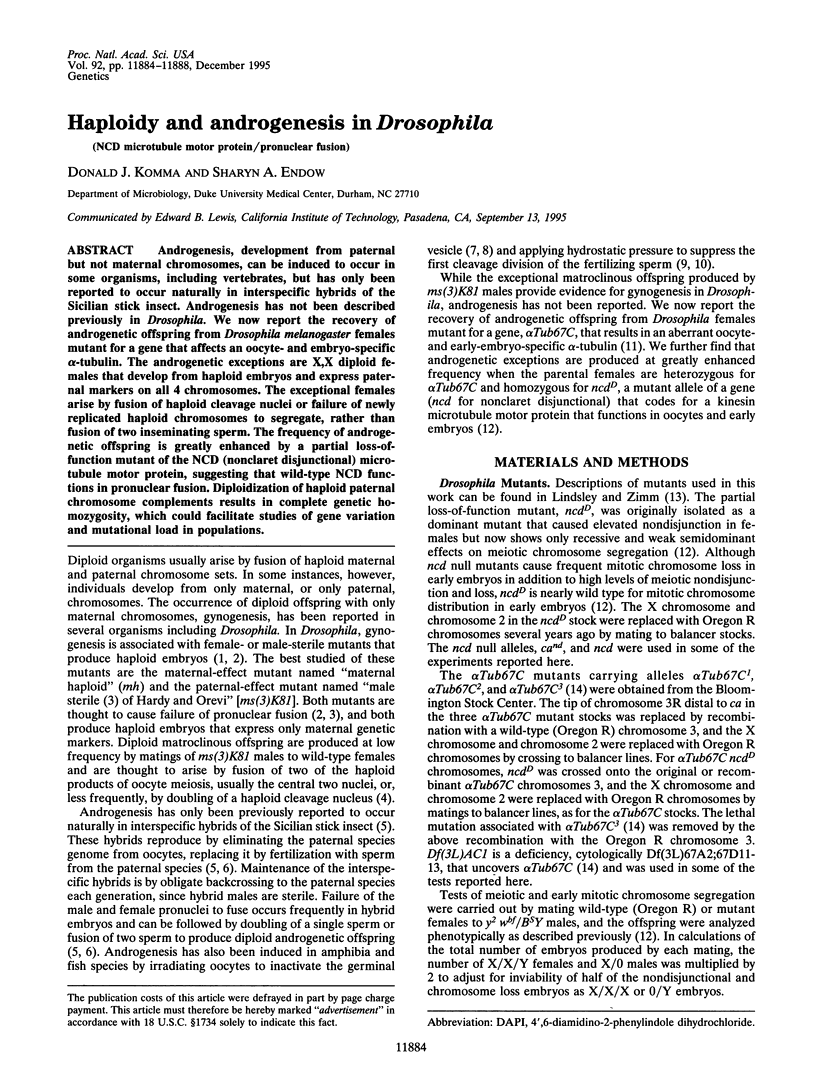
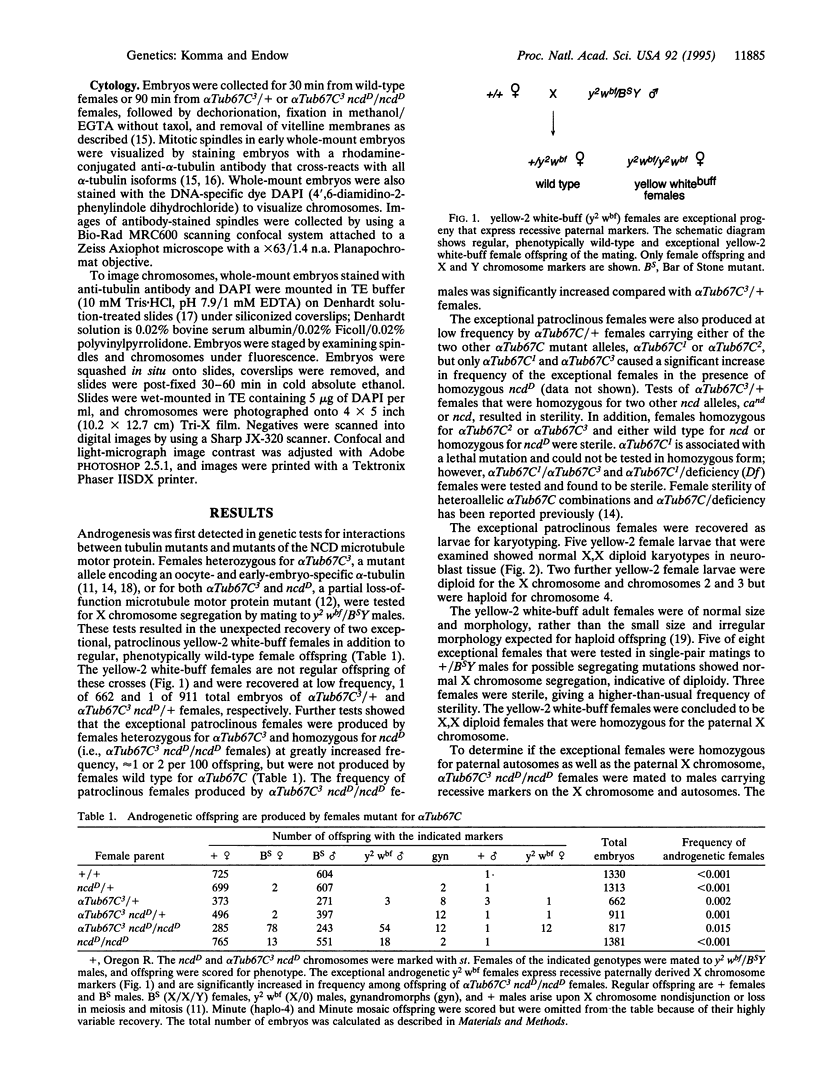
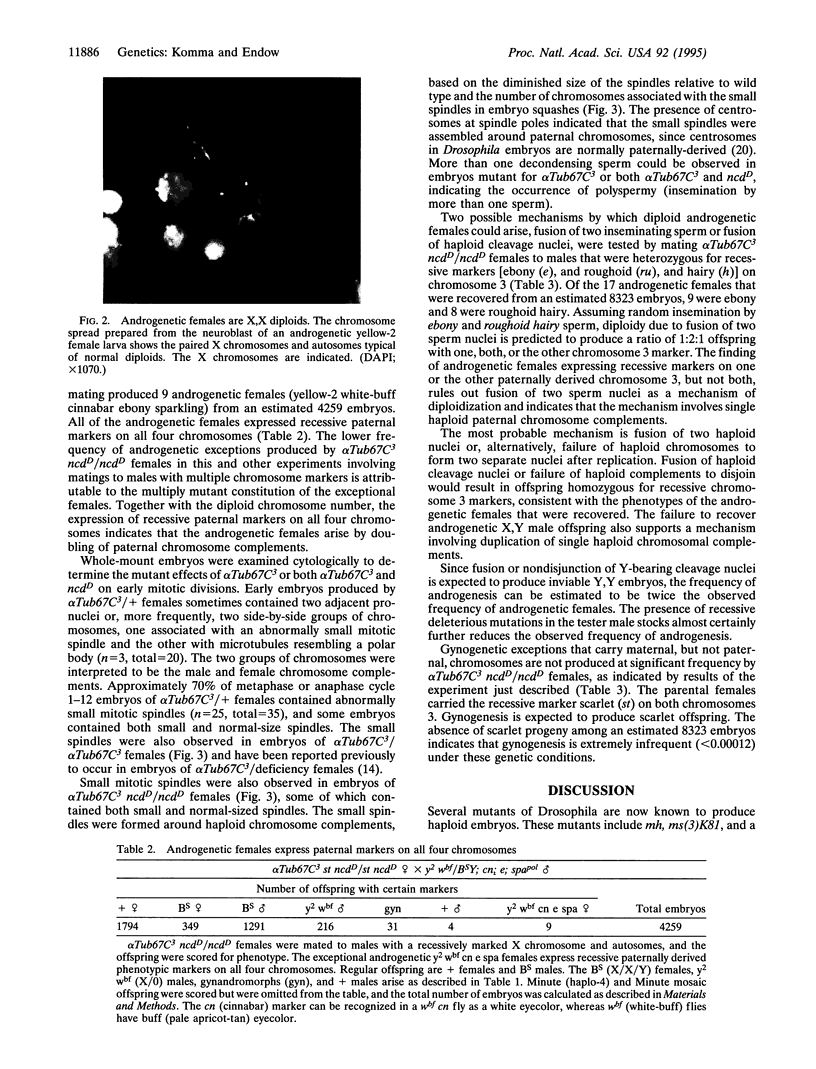
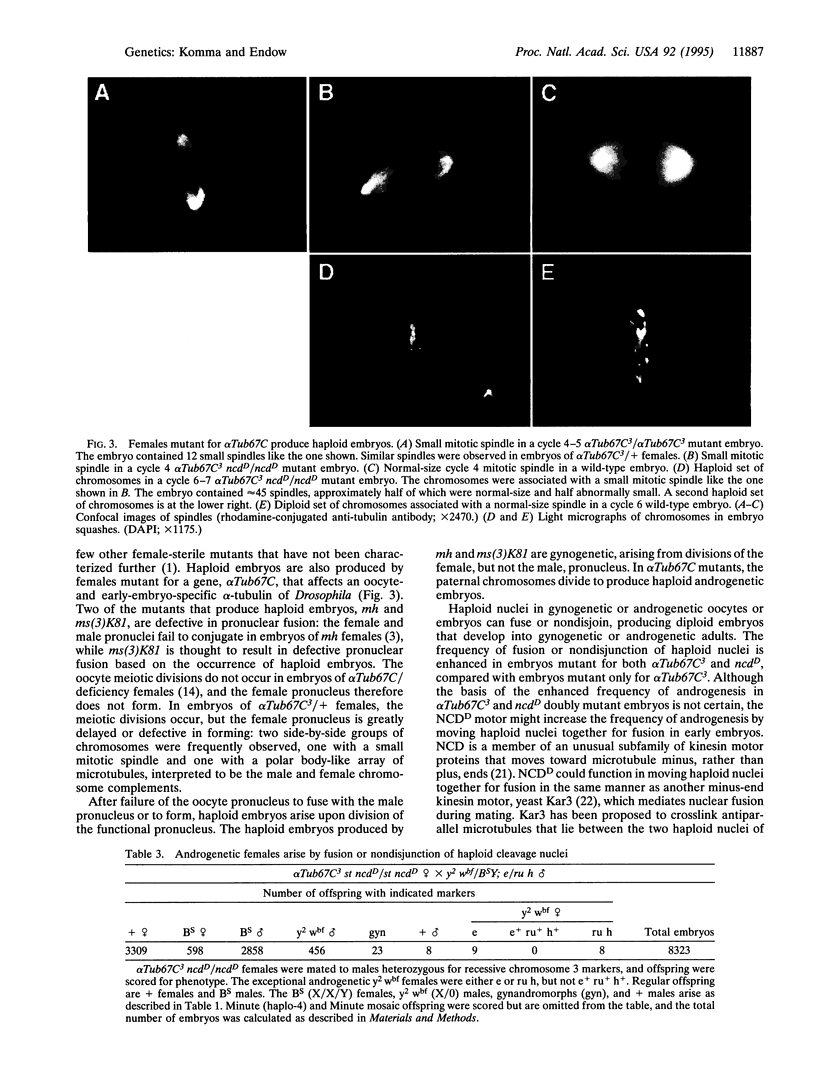
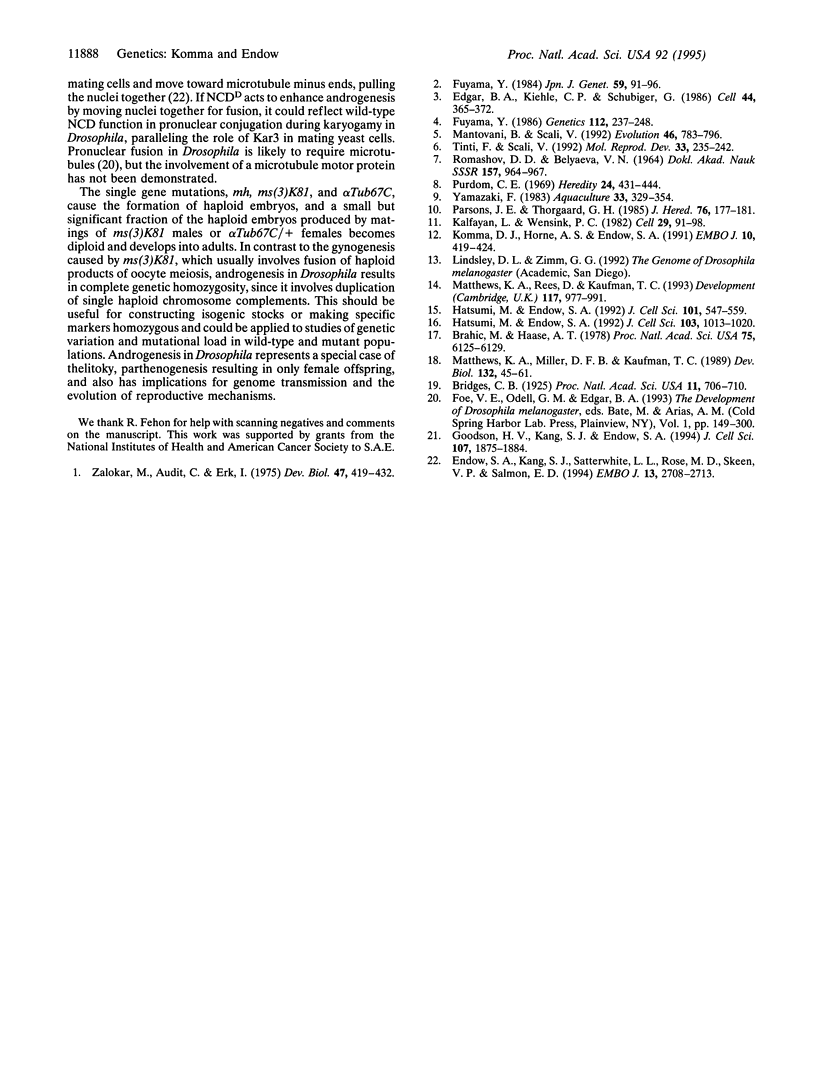
Images in this article
Selected References
These references are in PubMed. This may not be the complete list of references from this article.
- Brahic M., Haase A. T. Detection of viral sequences of low reiteration frequency by in situ hybridization. Proc Natl Acad Sci U S A. 1978 Dec;75(12):6125–6129. doi: 10.1073/pnas.75.12.6125. [DOI] [PMC free article] [PubMed] [Google Scholar]
- Bridges C. B. Haploidy in Drosophila Melanogaster. Proc Natl Acad Sci U S A. 1925 Nov;11(11):706–710. doi: 10.1073/pnas.11.11.706. [DOI] [PMC free article] [PubMed] [Google Scholar]
- Edgar B. A., Kiehle C. P., Schubiger G. Cell cycle control by the nucleo-cytoplasmic ratio in early Drosophila development. Cell. 1986 Jan 31;44(2):365–372. doi: 10.1016/0092-8674(86)90771-3. [DOI] [PubMed] [Google Scholar]
- Endow S. A., Kang S. J., Satterwhite L. L., Rose M. D., Skeen V. P., Salmon E. D. Yeast Kar3 is a minus-end microtubule motor protein that destabilizes microtubules preferentially at the minus ends. EMBO J. 1994 Jun 1;13(11):2708–2713. doi: 10.1002/j.1460-2075.1994.tb06561.x. [DOI] [PMC free article] [PubMed] [Google Scholar]
- Fuyama Y. Genetics of Parthenogenesis in DROSOPHILA MELANOGASTER. I. the Modes of Diploidization in the Gynogenesis Induced by a Male-Sterile Mutant, ms(3)K81. Genetics. 1986 Feb;112(2):237–248. doi: 10.1093/genetics/112.2.237. [DOI] [PMC free article] [PubMed] [Google Scholar]
- Goodson H. V., Kang S. J., Endow S. A. Molecular phylogeny of the kinesin family of microtubule motor proteins. J Cell Sci. 1994 Jul;107(Pt 7):1875–1884. doi: 10.1242/jcs.107.7.1875. [DOI] [PubMed] [Google Scholar]
- Hatsumi M., Endow S. A. Mutants of the microtubule motor protein, nonclaret disjunctional, affect spindle structure and chromosome movement in meiosis and mitosis. J Cell Sci. 1992 Mar;101(Pt 3):547–559. doi: 10.1242/jcs.101.3.547. [DOI] [PubMed] [Google Scholar]
- Hatsumi M., Endow S. A. The Drosophila ncd microtubule motor protein is spindle-associated in meiotic and mitotic cells. J Cell Sci. 1992 Dec;103(Pt 4):1013–1020. doi: 10.1242/jcs.103.4.1013. [DOI] [PubMed] [Google Scholar]
- Kalfayan L., Wensink P. C. Developmental regulation of Drosophila alpha-tubulin genes. Cell. 1982 May;29(1):91–98. doi: 10.1016/0092-8674(82)90093-9. [DOI] [PubMed] [Google Scholar]
- Komma D. J., Horne A. S., Endow S. A. Separation of meiotic and mitotic effects of claret non-disjunctional on chromosome segregation in Drosophila. EMBO J. 1991 Feb;10(2):419–424. doi: 10.1002/j.1460-2075.1991.tb07963.x. [DOI] [PMC free article] [PubMed] [Google Scholar]
- Matthews K. A., Miller D. F., Kaufman T. C. Developmental distribution of RNA and protein products of the Drosophila alpha-tubulin gene family. Dev Biol. 1989 Mar;132(1):45–61. doi: 10.1016/0012-1606(89)90203-0. [DOI] [PubMed] [Google Scholar]
- Matthews K. A., Rees D., Kaufman T. C. A functionally specialized alpha-tubulin is required for oocyte meiosis and cleavage mitoses in Drosophila. Development. 1993 Mar;117(3):977–991. doi: 10.1242/dev.117.3.977. [DOI] [PubMed] [Google Scholar]
- Parsons J. E., Thorgaard G. H. Production of androgenetic diploid rainbow trout. J Hered. 1985 May-Jun;76(3):177–181. doi: 10.1093/oxfordjournals.jhered.a110060. [DOI] [PubMed] [Google Scholar]
- Purdom C. E. Radiation-induced gynogenesis and androgenesis in fish. Heredity (Edinb) 1969 Aug;24(3):431–444. doi: 10.1038/hdy.1969.59. [DOI] [PubMed] [Google Scholar]
- ROMASHOV D. D., BELIAEVA V. N. K VOPROSU O TSITOLOGII RADIATSIONNOGO GINOGENEZA I ANDROGENEZA U V'IUNA (MISGURNUS FOSSILIS L.) Dokl Akad Nauk SSSR. 1964 Aug 1;157:964–967. [PubMed] [Google Scholar]
- Tinti F., Scali V. Genome exclusion and gametic DAPI-DNA content in the hybridogenetic Bacillus rossius-grandii benazzii complex (Insecta Phasmatodea). Mol Reprod Dev. 1992 Nov;33(3):235–242. doi: 10.1002/mrd.1080330302. [DOI] [PubMed] [Google Scholar]
- Zalokar M., Audit C., Erk I. Developmental defects of female-sterile mutants of Drosophila melanogaster. Dev Biol. 1975 Dec;47(2):419–432. doi: 10.1016/0012-1606(75)90295-x. [DOI] [PubMed] [Google Scholar]




